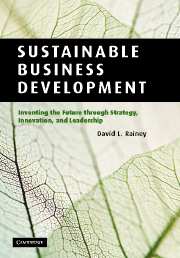Book contents
- Frontmatter
- Contents
- List of figures
- List of tables
- List of boxes
- List of abbreviations
- Acknowledgments
- Introduction
- Part I Enterprise thinking, the driving forces of change, and leadership
- 1 Sustainable business development: overview and guiding principles
- 2 Enterprise thinking and the strategic logic of strategic business development
- 3 Crafting sustainable business strategies and solutions
- 4 The driving forces of social-, economic-, and environmental-related change
- 5 The driving forces of markets and stakeholders' connectedness
- 6 Crafting a sustainable enterprise through leadership and capabilities
- Part II Innovation management, life cycle considerations, and insights
- Glossary
- Select bibliography
- Index
- References
2 - Enterprise thinking and the strategic logic of strategic business development
from Part I - Enterprise thinking, the driving forces of change, and leadership
Published online by Cambridge University Press: 04 December 2009
- Frontmatter
- Contents
- List of figures
- List of tables
- List of boxes
- List of abbreviations
- Acknowledgments
- Introduction
- Part I Enterprise thinking, the driving forces of change, and leadership
- 1 Sustainable business development: overview and guiding principles
- 2 Enterprise thinking and the strategic logic of strategic business development
- 3 Crafting sustainable business strategies and solutions
- 4 The driving forces of social-, economic-, and environmental-related change
- 5 The driving forces of markets and stakeholders' connectedness
- 6 Crafting a sustainable enterprise through leadership and capabilities
- Part II Innovation management, life cycle considerations, and insights
- Glossary
- Select bibliography
- Index
- References
Summary
Introduction
With the expanded globalization of the world's economies, the intensification of competition, and the quantum leaps in technological development during the latter part of the twentieth century, the insular strategic management of many global corporations has become inadequate for understanding the business environment and determining strategic direction. Global corporations require a higher level of sophistication for responding to all of the forces impinging upon them – their supply networks, allies, partners, stakeholders, and customers. They must think more broadly about what a global corporation is. Today, a corporation has to consider all of the effects, implications, and impacts of its businesses, operations, resources, and capabilities and those of its customers, stakeholders, and supporting entities from cradle-to-grave, including the sources of raw materials and EoL considerations. This more inclusive perspective involves enterprise thinking. An enterprise view of a global corporation encompasses all of the entities, organizations, and relationships that are required to formulate and implement strategies and to achieve the objectives of the corporation in the present and future and to mitigate the internal and external negative impacts of decisions and actions.
Enterprise thinking takes a holistic view of the corporation and its business environment. It involves recognizing and managing the full reach of the corporation across space and time, all of the actions and transgressions of all of the direct and supporting players, even those many levels deep in the supply networks or customer applications.
- Type
- Chapter
- Information
- Sustainable Business DevelopmentInventing the Future Through Strategy, Innovation, and Leadership, pp. 72 - 149Publisher: Cambridge University PressPrint publication year: 2006



